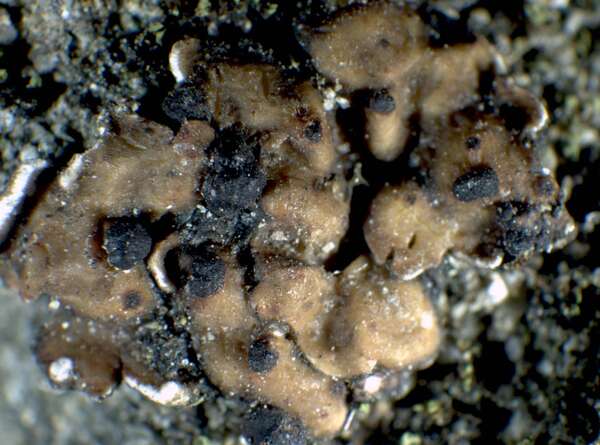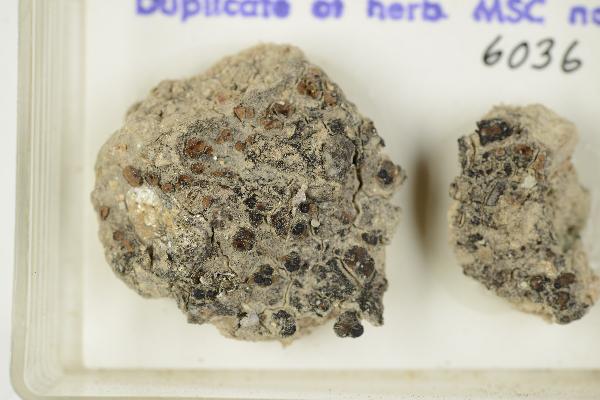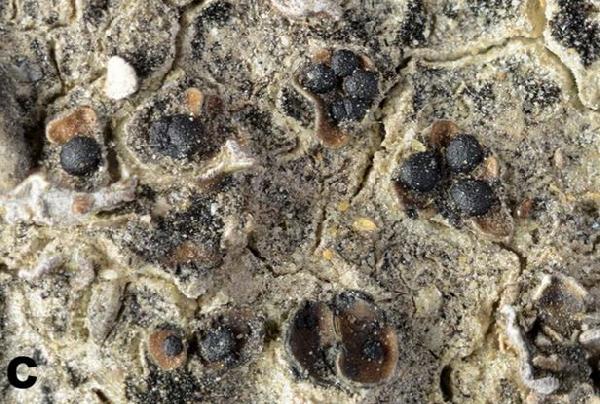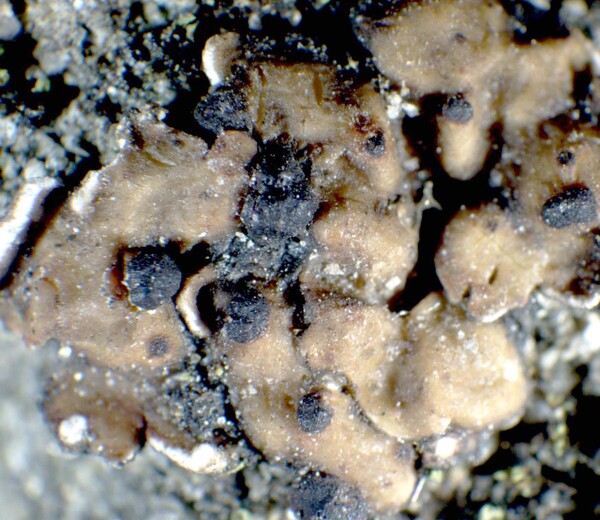Psora gresinonis B. de Lesd.
Bull. Soc. Bot. France, 77: 614, 1930.
Synonyms: Lecidea gresinonis (B. de Lesd.) Zahlbr.
Distribution: N - Lig. C - Sar. S - Cal (Puntillo 1996).
Description: Thallus squamulose, the squamules olivaceous brown to dark brown, epruinose, 2-3 mm wide, rounded, adnate, scattered to contiguous, with ascending, grey-edged margins. Upper surface finely divided by small fissures; lower surface whitish. Apothecia biatorine, sessile, up to 5 mm across, with a black, convex disc and a thin, mostly indistinct and soon excluded proper margin. Epithecium reddish brown, K+ red; hymenium colourless, I+ blue; paraphyses anastomosing, conglutinated; hypothecium dark brown, with crystals of calcium oxalate. Asci 8-spored, elongate-clavate, with a thin, outer amyloid layer and a thickened tholus penetrated by a tube, the sides of which stain I/KI+ deep blue, without an ocular chamber, Porpidia-type. Ascospores 1-celled, hyaline, ellipsoid, thin-walled, 12-15 x 6-8 µm. Photobiont chlorococcoid. Spot tests: cortex K-, C-, KC-, P-, UV-; medulla K+ yellow turning red. Chemistry: cortex without lichen substances, medulla with norstictic acid; epithecium with anthraquinones.Note: on soil, in fissures of base-rich or slightly calciferous siliceous rocks, with optimum in dry grasslands at relatively low elevations; chemically heterogeneous (with and without norstictic acid), with a mainly Tyrrhenian range in Italy.
Growth form: Squamulose
Substrata: soil, terricolous mosses, and plant debris
Photobiont: green algae other than Trentepohlia
Reproductive strategy: mainly sexual
Commonnes-rarity: (info)
Alpine belt: absent
Subalpine belt: absent
Oromediterranean belt: absent
Montane belt: absent
Submediterranean belt: extremely rare
Padanian area: absent
Humid submediterranean belt: very rare
Humid mediterranean belt: very rare
Dry mediterranean belt: absent

Predictive model
Herbarium samples


P.L. Nimis; Owner: Department of Life Sciences, University of Trieste
Herbarium: TSB (10088)
2001/11/29

Source: https://nhm2.uio.no/typephotos/lichens/arkiv/O-L-000133d.jpg
ITALY, LIGURIA: Liguria occid.: Spotorno. In argillosis loco La Torre, 1949.05.29, Sbarbaro, C. - ISOTYPE

Source: Evankow, A.M., Yin, A., Zulfiqar, R. et al. Psora mediterranea (Lecanorales, Psoraceae), a new lichen species from Europe, including a new concept for P. himalayana and a revised key to the European species. Mycol Progress 24, 26 (2025). https://doi.org/10.1007/s11557-025-02045-8 - CC BY 4.0
Italy, isotype: O-L-133, Photo: E. Timdal
Growth form: Squamulose
Substrata: soil, terricolous mosses, and plant debris
Photobiont: green algae other than Trentepohlia
Reproductive strategy: mainly sexual
Commonnes-rarity: (info)
Alpine belt: absent
Subalpine belt: absent
Oromediterranean belt: absent
Montane belt: absent
Submediterranean belt: extremely rare
Padanian area: absent
Humid submediterranean belt: very rare
Humid mediterranean belt: very rare
Dry mediterranean belt: absent

Predictive model
| Herbarium samples |


P.L. Nimis; Owner: Department of Life Sciences, University of Trieste
Herbarium: TSB (10088)
2001/11/29

Source: https://nhm2.uio.no/typephotos/lichens/arkiv/O-L-000133d.jpg
ITALY, LIGURIA: Liguria occid.: Spotorno. In argillosis loco La Torre, 1949.05.29, Sbarbaro, C. - ISOTYPE

 Index Fungorum
Index Fungorum
 GBIF
GBIF


